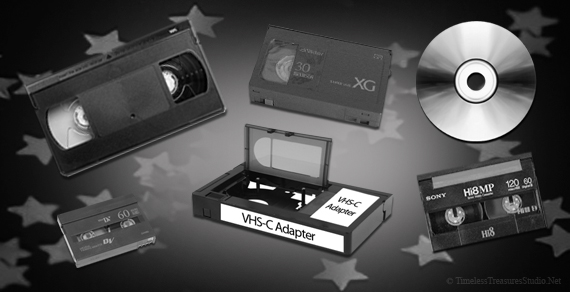
VHS, VHS-C, MiniDV, CD & DVD to Disc, USB, or External Hard Drive
THIS PROCESS IS A BASIC VIDEO FORMAT CONVERSION. IT INVOLVES A CONVERSION ONLY AND DOES NOT INCLUDE ANY EDITING.
OUTPUT TO DVD:
| Onto DVD: | Master (first copy) | 2-10 copies | 11+ copies | 50+ copies | 100+ copies |
| Under 1 hour: | $20 | $15 ea. | $12 ea. | $8 ea. | $5 ea. |
| Over 1 hour: | $30 | $20 ea. | $15 ea. | $10 ea. | $7 ea. |
A disc includes:
* A basic menu
* A DVD case with basic insert
More than two items per disc is an addition $5.00 per item.
OUTPUT TO DRIVE:
| Onto Drive: | Master (first copy) | 2-10 copies | 11+ copies | 50+ copies | 100+ copies |
| Under 1 hour: | $20 | $4 ea. | $3 ea. | $2 ea. | $1 ea. |
| Over 1 hour: | $30 | $5 ea. | $4 ea. | $3 ea. | $2 ea. |
A digital drive includes:
* A conversion of your video in an organized folder on your drive.
PRICES INCLUDE TRANSFERRING LABOR BUT NOT THE DRIVES THEMSELVES. PRICES OF DRIVES DEPEND ON THE SIZE NEEDED OR DESIRED, AS WELL AS THE CURRENT PRICE OF THE DRIVES THEMSELVES.
We currently do not transfer Hi8 tapes or Beta tapes.
We also do not transfer copyrighted material, such as television shows or movies.
ADDITIONAL SERVICES
If professional services are desired after your transfer, you will then be charged for the time it takes to complete your request.
If a professional, interactive DVD menu is desired, and/or any video editing, your request then falls under professional video editing services.
Sift Through the Storage!
Videotapes should be stored vertically, in a dark, cool, and dry environment and away from dust. Videotape media consists of chromium dioxide, or chromium (IV) oxide, which is a synthetic magnetic substance. Over time, this media will break down, resulting in decreased quality of the video image and the increase of image noise The lifespan of analog tape is about 10 to 15 years. After that amount of time, some deterioration may be detectable.